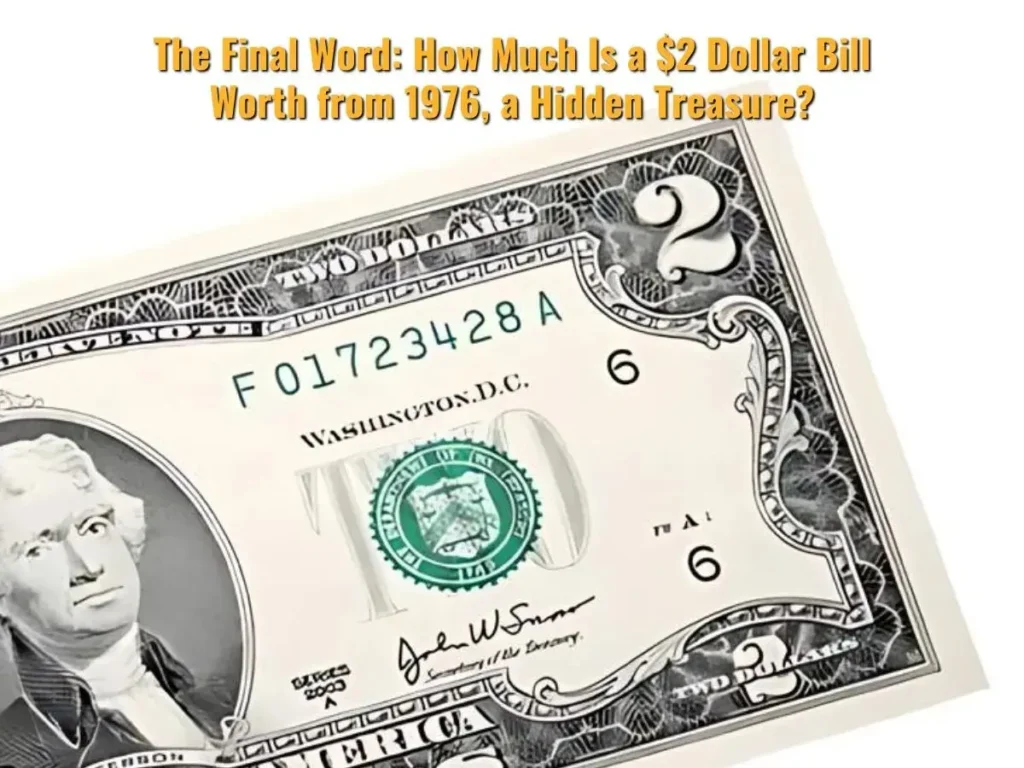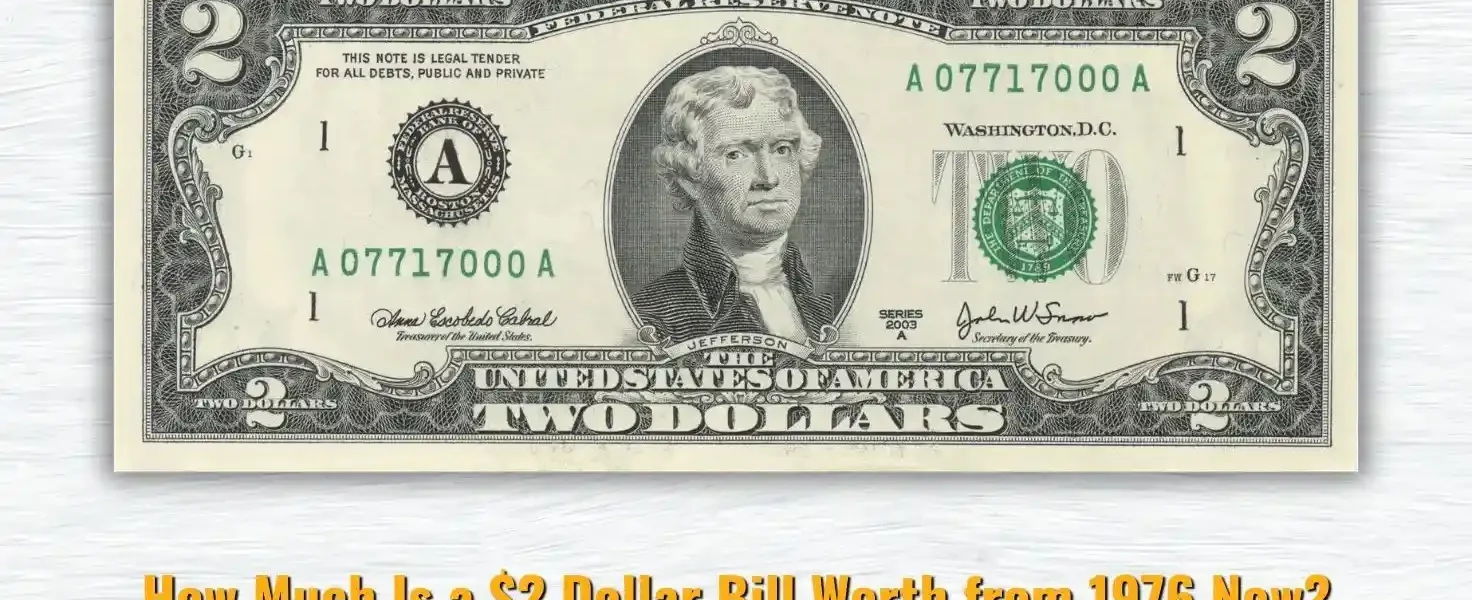Do you know how much is a $2 dollar bill worth from 1976? Did you ever think about what the value of a 1976 two-dollar bill is? One such treasure that you can come across is that old note.
Do they actually print the serial numbers on the serial numbers on $2 bills, or do they even have any sort of bicentennial anniversary or even history of their own?
Most \$2 bills hold face value, but rare errors or markings can fetch hundreds or even thousands from dedicated collectors. So, now, we are going to take a look at the secrets behind making such bills so exciting presently.
The Story Behind: How Much Is a $2 Dollar Bill Worth from 1976

In 1976, for the U.S. bicentennial, a newly redesigned \$2 bill was issued to mark the special occasion. It was notable for featuring a vivid image of the Signing of the Declaration of Independence on the back.
The government printed the bills mainly as souvenirs, not regular currency. Many people kept them as keepsakes instead of spending them daily.
In case you have a crisp $2 bill with a date stamp of 1976, you have your part of $2 bill history in America.
The U.S. Mint printed half a billion bills for the occasion, making them collectible. Today, people eagerly search drawers for well-preserved ones.
Despite its special 1976 release and design, the $2 bill never gained widespread popularity for everyday use in wallets or shopping. There was a common feeling of embarrassment when paying these bills, hence most of them remained in circulation.
Owing to this fact, the value of such notes is very much dependent on whether they have remained in the possession of a few hands or whether they have been circulating. To use that in the discussion of uncirculated notes vs circulated notes, the key debate for any collector.
Why the $2 Bill Captures Collectors’ Attention
Of course, to collectors, the 1976 $2 bill is so much more than currency; we may look at it as a lovely relic of American pride. They are also rare in circulation, especially in the interest of the US rare currency collecting.
Collectors go through bills trying to find unique features and special qualities, such as a few serial numbers, a star note $2 bill from 1976, or just odd series.
You may even find one issued by different Federal Reserve Bank locations- these could be bearing additional interest as they were issued on the specific day, bicentennial day, i.e., 13 April 1976.
A few of them bear a first-day issue postmarks, making them more desirable to the serious collector. Specifically, collectors who are in-the-know adore the work of recognizing flaws in their collections.
Unusual features, star notes, or unique markings on a bill can significantly increase its desirability and potential collector value.
You can simply think of how exciting the voice of a collector can be once he comes across a rare bill with some peculiar features.
Most people can tell of the times that they have discovered a bill in an old forgotten wallet or even been given a tip amount as change, only to discover later that it is worth far more than the value one considers two dollars.
Key Factors Impacting a $2 Bill’s Value
What happens, though, is that how much is a $2 bill worth from 1976? The answer to this question is found in a series of important points. To begin with, the bill is colossal as a whole. A crisp, clean, and fresh bill is always more tempting to buy.
Second, the serial number is essential, especially the sequences of star notes (or stars and ladder notes) such as 12345678, which are exponentially appreciated.
Third, misprints or any other printing errors, e.g., with repeated serial numbers or off-center prints, make an ordinary bill into an extraordinary one.
The grading of the condition of $2 bills will be divided by terms such as Fine, Very Fine, Extremely Fine, and Uncirculated, and the clients may consult a U.S. currency value guide or research an expert who may be able to provide an appraisal regarding the condition of the currency to be graded.
The locations of the Federal Reserve locations on bills should not be ignored either, because the banks also have their own distinctive marking that can be of interest to a specialist audience.
In the end, these become details which affect rarity and certainly appeal, and even small flaws or peculiarities in signature or printing can skyrocket current $2 bill prices.
| Feature | Description | Typical Value (USD) |
| Regular Circulated | Used, shows wear | $2–$552 |
| Uncirculated | Crisp, untouched | $10–$50534 |
| Star Note | in serial number | $20–$500+32 |
| Rare Serial Number | Ladder, low, repeating | $50–$20,000**24 |
| Printing Error | Double serial, misprints | $500–$5,000+52 |
| First-Day Postmark | Stamped, city mark | $9–$100+62 |
The Value Chart: How Much Is a $2 Dollar Bill Worth from 1976?
The value of the $2 bill of 1976 is the problem of perceiving figures and actual market movements. An ordinary note that is not in good shape but in average condition has a face value.
But a nice, uncirculated 1976 2-dollar bill will not be hard to find, as some collectors will pay a premium to get it.
We rarely see items like bills with star notes, misprints, or other high serial bills, and they can fetch several hundred or even thousands of dollars to the right person.
There have been unique bills, such as those with a serial number of 1; these bills have sold in recent years at expert auctions for over 20,000 dollars.
Worried about the value and worth of two-dollar bills from 1976? This is where you search through the recent U.S. currency value guides or refer to the value charts on currency websites.
All these materials provide an updated trend of prices and present a clear response to both common and rare occurrences.
How to Check the Value of Your $2 Bill
A layman can determine whether his or her 1976 2 dollar bill contains secret value or not. The first thing you may want to do is to check the condition grading of the bill- is it battered or still pristine, with sharp edges and full color?
Look at the serial number, is it a unique serial number, or is it a star note, or does it have a rare design? Shake to see the printing errors like mix-up of numbers and seals, etc., or any ink puffs which are not known.
In case you are not sure, you can address a professional who will help you by appraising it. The majority of individuals rely on online auction websites, like eBay, to observe the current price levels at which rare 2-dollar bills have moved.
However, it is wise to consult coin dealers who offer their services and expertise before committing to either selling or purchasing rare 2-dollar bills. A guide or app devoted to the process can speed it up by explaining how to estimate the value of U.S. currency.
Some collectors use digital products where the serial number of the bill is scanned to identify it immediately and determine whether the bill is rare or not.
Others are interested in knowing whether their bill corresponds with records of known error notes which have no prices in the collections of the collectors.
Uncirculated vs. Circulated: Understanding the Difference
Uncirculated refers to a bill that is like new except that there are no tears, folds, or stains on it. Circulated means that someone touched it, sold it, or had it in a pocket-book.
This difference matters a lot in terms of value. An uncirculated vs circulated note is sought after by collectors immensely, more so with the 1976 dollar bills worth $2.
An unissued or misprinted note can fetch \$10, \$50, or more. But a creased, worn 1976 \$2 bill may be worth nothing. Finding a clean 1976 2 bill would be like a hidden treasure hunt because they do not come out of personal collections.
Notorious $2 Bills: Highlights from History
There are a lot of tales and bills that have more value in the realm of the US rare currency collecting than their face value. Early \$2 bills like the 1862 Legal Tender or 1890 Treasury Note can now be worth thousands or more.
The “Red Seal” of 1928 and 1953 notes also have a very good appreciation for their high quality of color, whereas the bicentennial note of 1976, the $2 bill value is appreciated more for its characteristics rather than age. A table of infamous 2-dollar bills indicates the extent of value that such old historical notes may carry.
| Year/Type | Notable Feature | Value Estimate (USD) |
| 1862 Legal Tender | Old, rare design | $500–$10,000+ |
| 1890 Treasury | Distinct gold seal | $1,000–$69,000+ |
| 1928 Red Seal | Red serial, small size | $30–$2,000 |
| 1953, 1963 Red | Later red seals | $20–$150 |
| 1976 Bicentennial | Green seal, unique design | $2–$20,000+ |
Are There Special 1976 $2 Bills Worth More?
Absolutely. A bicentennial 1976 bicentennial $2 bill can receive a significant boost in terms of value should they be given serial numbers, star notes or even postal stamps. The names to look out for are serial numbers that begin with 00000001 and fancy ones and even what is so-called ladder type serial number patterns like 12345678.
Or at least pay attention to the issues that have a star note a $2 bill, 1976 bill, or lack thereof found in them, or even find a $2 bill with errors in them worth mentioning, such as a big mistake or double serial numbers. These can be collected, and one can inquire about hundreds or even thousands of them, depending on their rarity and condition.
People who knew nothing about the special bill have shared wild stories. Some bought \$2 bills at face value and later sold them for thousands due to lucky serial numbers or printing mistakes.
Quotes by well-known collectors indicate that, in 1976, $2 bill with serial number 1 would be worth $20,000 or more, and this just shows how crazy the world can get due to the right example.
Selling Your Valuable $2 Bill: Tips & Resources
Do not sell your rare or valuable $2 bill immediately, just because you see others selling them at a high price. For accurate valuation, consult a reputable coin dealer or attend a money fair for a professional appraisal.
Check your bill’s value in a U.S. currency guide or on auction sites. Beware of prices that seem too good to be true.
You can be more certain about the value placed in the appraisal of a 1976 $2 bill by studying the steps involved in the valuation of currency with able experts in the field through resources, databases, or the like, which are meant to evaluate them.
Take accurate pictures of your rare bill, state serial numbers, and identifying aspects of your bill to the best of your ability, creating a listing to sell the bill.
This builds confidence, and it may even initiate a bidding war amongst those collectors who want to get their next prized piece.
The Final Word: How Much Is a $2 Dollar Bill Worth from 1976, a Hidden Treasure?

The 1976 \$2 bill may seem ordinary at first glance, but its actual value could surprise you. A \$2 bill gains value with rare serials, excellent condition, and a story, sometimes turning into a surprising payday.
When you have one, examine it carefully like a true collector. If you’re lucky to find an old bill or star note, preserve it quickly. To most, finding a valuable two-dollar bill feels like discovering a hidden treasure. It’s where luck, history, and curiosity reward us.
Conclusion:
Having a 1976 $2 bill in possession may be more than a sentimental keepsake; it may be a valuable prospect, as well, based on its condition, rare serial numbers, or features such as a star note.
Most 1976 \$2 bills hold face value, but rare marks or top condition can raise prices significantly. Whether selling, budgeting, or intrigued by its story, start with research. Knowing the actual value of a 1976 \$2 bill is key.
FAQs:
How much money is a 2 dollar bill worth and value?
Most $2 bills in circulation today are worth just face value. Only rare series, uncirculated notes, or printing errors increase value.
How many of the 2 dollar bills of 1976 are there?
The Bureau of Engraving and Printing printed 590.7 million Series 1976 $2 bills. People kept most as mementos, so many still circulate today.
What are the ways to authenticate two-dollar papers from 1976?
Counterfeiters print fake bills on special paper with raised prints, include blue and red security fibers, and assign unique number codes.
How much is my Red Seal 2?
Perhaps the coin that is on the biggest problem is the Red Seal 2. Red seal \$20 bills from 1928 or 1953 range in value from \$5 to \$175, based on series.
What does 1976 2 on dollar bill signify with green seal on it?
A 1976 green seal 2 dollar bill will have a value of 2 dollar bills. Uncirculated bills may fetch \$5–\$10; star notes, errors, or rare serials can reach several hundred dollars.








